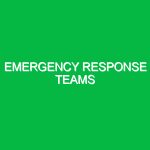In the realm of Health, Safety, and Environment (HSE), the act of reporting fires and emergencies is not merely a procedural formality; it is a critical component that can save lives and minimize damage. Whether in an industrial setting, a corporate office, or a public venue, understanding the intricacies of reporting incidents effectively can make a significant difference in outcomes. This article explores the importance of reporting fires and emergencies, the potential hazards involved, safety precautions, best practices, regulations, and standards relevant to this essential activity.
Understanding Reporting Fires and Emergencies
Reporting fires and emergencies encompasses the systematic process of notifying relevant authorities and stakeholders about incidents that pose immediate threats to life, property, or the environment. This process includes not just the act of communication, but also the preparation, training, and implementation of protocols that enable timely and effective responses. The significance of accurate reporting cannot be overstated; a swift report can trigger emergency responses that mitigate damage and protect lives.
The Relevance of Reporting in the HSE Context
In the HSE domain, the consequences of failing to report a fire or emergency can be dire. Delayed responses can lead to greater property damage, increased injury rates, and even fatalities. Organizations are tasked with ensuring that all employees are trained in recognizing potential hazards and understanding the reporting procedures. For example, a manufacturing plant that experiences a minor fire due to equipment malfunction must report the incident promptly to prevent escalation. The HSE regulations often stipulate that organizations maintain clear communication channels for reporting such incidents, ensuring that incidents are logged, investigated, and mitigated appropriately.
Identifying Hazards and Risks Associated with Reporting Fires and Emergencies
While the act of reporting itself may seem straightforward, the context in which it occurs presents various hazards and risks. Recognizing these potential issues is essential for effective emergency management.
Common Hazards
1. **Physical Hazards**: Fires can create immediate physical dangers, such as smoke inhalation and burns. For instance, in a chemical manufacturing facility, a chemical fire can release toxic fumes, posing a significant risk to employees if not reported swiftly.
2. **Environmental Hazards**: Emergencies involving hazardous materials can lead to environmental contamination. For instance, a spill of hazardous substances during a fire can pollute soil and water sources, necessitating urgent reporting to environmental authorities.
3. **Operational Risks**: Inadequate reporting can disrupt operational processes. If a fire is not reported in a timely fashion, it can lead to extended downtimes and financial losses. A real-world example includes a warehouse fire that went unreported for an hour, resulting in the loss of inventory worth thousands of dollars.
Psychological and Social Risks
Beyond the physical and operational hazards, the psychological impact on employees must not be overlooked. Witnessing a fire or emergency incident can induce trauma. Organizations need to provide support systems, including counseling, to help employees cope with the aftermath. Furthermore, poor reporting practices can lead to a culture of fear, where employees hesitate to report incidents, fearing retribution or criticism.
Safety Precautions and Best Practices for Reporting Fires and Emergencies
To mitigate the risks associated with fires and emergencies, organizations must implement a range of safety precautions and best practices. These practices not only enhance safety but also streamline the reporting process.
Developing a Reporting Protocol
Establishing a clear, well-documented reporting protocol is paramount. This protocol should outline the steps employees need to follow when an incident occurs. It should include:
- Immediate Actions: What to do first when a fire is detected, such as activating alarms or using fire extinguishers.
- Notification Procedures: Whom to notify and how (e.g., through a dedicated emergency number or system).
- Documentation: How to document the incident for record-keeping and future analysis.
Training and Drills
Regular training and drills are crucial for ensuring that employees are familiar with reporting procedures. These drills should simulate real-life scenarios, allowing employees to practice their responses. For example, conducting a fire drill where employees must report a mock fire to the authorities can help reinforce the importance of swift reporting.
Encouraging Open Communication
A culture of open communication encourages employees to report incidents without fear. Organizations should foster an environment where reporting is viewed as a responsibility rather than a punitive measure. This can be achieved through regular discussions about safety, recognition of employees who report incidents, and transparent communication about the importance of reporting for overall safety.
Regulations and Standards Governing Reporting Fires and Emergencies
Various regulations and standards govern the processes surrounding reporting fires and emergencies. These regulations vary across industries and regions, but they share a common goal: to ensure safety and accountability.
Key Regulations
1. **Occupational Safety and Health Administration (OSHA)**: In the United States, OSHA mandates that employers ensure a safe working environment. This includes maintaining protocols for reporting incidents and training employees on emergency procedures.
2. **National Fire Protection Association (NFPA)**: The NFPA sets standards for fire safety, including reporting practices. Their codes provide guidelines on how organizations should prepare for and respond to fires.
3. **Environmental Protection Agency (EPA)**: The EPA regulates the reporting of hazardous materials and incidents that could impact the environment. Organizations must be aware of their obligations under the Clean Air Act and the Clean Water Act when reporting fires involving hazardous substances.
International Standards
ISO standards, such as ISO 45001, provide frameworks for occupational health and safety management systems. These standards emphasize the importance of risk assessment and incident reporting as components of an effective safety management system.
Conclusion
Reporting fires and emergencies is a critical function that intersects directly with health, safety, and environmental management. Understanding the potential hazards associated with emergencies, along with implementing robust reporting protocols, can significantly enhance an organization’s safety culture. Through effective training, clear communication, and adherence to regulations, organizations can not only respond to incidents more efficiently but also foster a proactive approach to safety. As we navigate increasingly complex environments, the importance of timely reporting and effective emergency management cannot be overstated. It is an ongoing responsibility that requires commitment at all levels of an organization.


